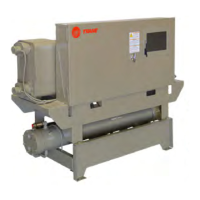Installation
18 CG-SVX038A-EN
1. Remove the stretch wrap from the unit as described In
the Handling section, leaving the unit mounted to the
skid. The lifting rails should be mounted to the skid.
Remove the rails from the skid.
2. The hardware used to secure the lifting rails to the unit
frame can be found in a box in the unit control panel.
Insert the lifting rails as shown in the above figure.
Using the mounting hardware, secure the lifting rails to
the unit frame by torquing the 1/2” bolts to 70 ft-lbs.
3. Install clevis connectors or equivalent in the 1-1/4 inch
l
ifting holes provided at each end of the lifting rails.
4. Attach certified lifting chains (cables) to these points.
E
ach chain (cable) alone must be strong enough to lift
the unit.
5. Attach chains (or cables) to a li
fting beam. Position the
chains (cables) so that they do not contact the unit
piping or the unit control panel. Use a suitable
spreader bar to insure proper weight distribution.
6. Remove the bolts that secure the unit to the shipping
skid.
7. Raise the unit just off the skid
to make sure that the unit
is level when lifted. Adjust chain (cable) lengths as
required for level lifting.
8. Lift the unit off of the skid a
nd place in the installation
location.
Access Restrictions
All CCAR/CGWR units are designed to pass through a
standard 36-inch doorway. Refer to outline drawings for
other important dimensions.
Trane does not recommend disassembling a CGWR/CCAR
to gain access through challenging rigging paths and
installation locations. If disassembly/reassembly of a
chiller does take place, please note the following:
1. A qualified Trane technician must perform the task
2. Use technical support for any questions that m
ay arise
during the task
3. Be aware that disassembly/reassembly could possibly
af
fect warranty status of the chiller, especially if failure/
issues occur that point toward improper reassembly &
installation
4. All required installation and star
tup checklists are still
required to be completed and promptly returned for
review, including the required running data log as
instructed in the startup checklist
Direct Mounting
The unit can be installed directly on an isolated, rigid
mounting surface as long as the surface is level and will
support the weight of the unit. A mounting hole is
provided at each of the unit mounting locations. Provide a
means of securely anchoring the unit to the mounting
surface. Level the unit carefully.
Neoprene Isolator Pad Mounting
(Optional)
The optional neoprene isolator pads are to be placed
between the direct mounting surface and each of the
chiller's mounting locations. To help distribute the chiller's
load to the neoprene pads, place the 6" x 6" mounting
plates between each pad and the chiller. Provide a means
of securely anchoring the chiller to the mounting surface.
Level the unit carefully as instructed in “Unit Leveling,”
p. 18.
Compressor Mounting
All compressors are rigidly bolted with compressor
isolation mounts to compressor mounting rails (tandem
compressor sets) or directly to the unit base. No additional
isolation or leveling is required. Inspect prior to start up to
insure bolts are present and tight, and that no shipping
damage has occurred.
Unit Leveling
Before tightening the mounting bolts, level the unit front-
to-back and end-to-end. Unit must be level within 1/4”
from front-to-back and within 1/4” over the length of the
unit. The unit’s base deck can be used for leveling. Use
shims as required to properly level unit base.
Compressor Nameplate
The nameplate for the hermetic scroll compressor is
mounted on the compressor housing, near the motor
terminal junction box.
Evaporator Nameplate
The evaporator nameplate is mounted on evaporator
under the insulation. To view the evaporator nameplate,
remove the insulation over the area if covered and spread
the insulation. The serial number information is also on
record at the factory.
Condenser Nameplate
The condenser ASME nameplate is mounted on the side of
the condenser.
NOTICE:
Equipment Damage!
To prevent damage to the unit, position the lifting beam
and chains (cables) so that they do not contact the unit
piping or the unit control panel.

